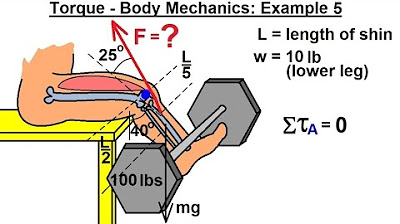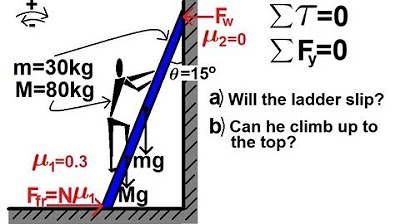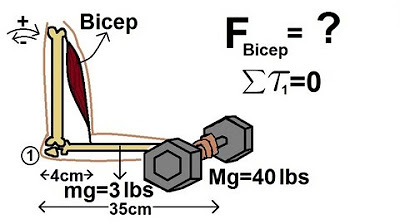Physics 15 Torque (15 of 27) Body Mechanics: Ex. 3, F=? on Achilles Tendon***
TLDRIn this fascinating lecture, the presenter delves into the remarkable strength of the human Achilles tendon. The discussion is centered around a scenario where an 80 kg person stands on one foot, with the heel elevated at 15 degrees and the Achilles tendon making a 20-degree angle with the vertical. Using the principle of torques and equilibrium, the presenter calculates the force exerted by the Achilles tendon to be approximately 1995 Newtons, which translates to 448 pounds. This powerful demonstration illustrates the incredible resilience and strength of the human body, particularly the tendons and muscles, which are capable of supporting and propelling us through various physical activities such as running, jumping, and sprinting.
Takeaways
- 🤸 The Achilles tendon is a remarkable structure that supports the entire body weight during activities like jumping, sprinting, or running on toes.
- 🏃♂️ The force exerted by the Achilles tendon is crucial in maintaining balance, especially when standing on one foot.
- ⚖️ An 80 kg person standing on one foot exerts about 800 Newtons of force on the ground.
- 📐 The distances from the bone's pivot point to different parts of the foot are essential in calculating the force exerted by the Achilles tendon.
- 🔵 The concept of torques is used to analyze the forces acting on the foot when it's in equilibrium.
- 🔄 When in equilibrium, the sum of all torques about a point must equal zero, which helps in calculating the tension in the Achilles tendon.
- 📐 The perpendicular distance from the line of action of the force to the pivot point is a key factor in the torque calculation.
- 📐 The cosine of the angle between the force's direction and the vertical line is used to determine the effective force component.
- 🔢 The calculation involves finding the force (F_a) exerted by the Achilles tendon using the known force exerted by the person's weight and the distances involved.
- 💪 The Achilles tendon must exert a force of approximately 1995 Newtons, which is equivalent to 448 pounds, to hold a person in place on one foot.
- 🚀 During more dynamic activities like jumping, the Achilles tendon needs to exert even greater force, potentially over a thousand pounds.
- 🔬 Physics and torque principles allow us to understand and appreciate the strength and design of the human body, particularly the muscles and tendons.
Q & A
What is the function of the Achilles tendon?
-The Achilles tendon is a strong fibrous cord located at the back of the heel that attaches to the calf muscle. It supports the entire weight of an individual during activities like jumping, sprinting, or running on tiptoes.
What is the significance of the force exerted by the Achilles tendon when standing on one foot?
-The force exerted by the Achilles tendon is crucial for maintaining balance and stability when bearing weight on a single foot. In the given example, it is calculated to be 1995 Newtons or approximately 448 pounds.
How does the angle of the Achilles tendon affect the force it exerts?
-The angle of the Achilles tendon in relation to the vertical affects the direction and magnitude of the force it exerts. In the script, a 20-degree angle is mentioned, which, combined with the foot's 15-degree elevation, results in a 5-degree angle relative to the foot.
What is torque in the context of physics?
-In physics, torque is the rotational equivalent of linear force. It is a measure of the force that can cause an object to rotate around an axis and is calculated as the product of the force and the perpendicular distance from the force's line of action to the pivot point.
Why is it important for the sum of torques to be zero in equilibrium?
-When the sum of torques around a point is zero, it indicates that the object is in rotational equilibrium, meaning there is no net rotation or tendency to rotate. This is a critical condition for stability in many physical scenarios, including the one described in the script.
How is the distance from the pivot point to the point of force application relevant in calculating torque?
-The distance from the pivot point to the point of force application is a key factor in calculating torque. The greater the distance, the greater the torque produced by a given force, assuming all other factors remain constant.
What is the significance of the 800 Newton force mentioned in the script?
-The 800 Newton force represents the weight of an 80-kilogram person. It is the force that the Achilles tendon must counteract to keep the person balanced on one foot.
How does the cosine function play a role in calculating the distances and forces in the problem?
-The cosine function is used to calculate the horizontal components of the forces and distances involved. It is essential for determining the perpendicular distances from the lines of action of the forces to the pivot point.
What is the force exerted by the Achilles tendon when a person jumps or sprints?
-When a person jumps or sprints, the force exerted by the Achilles tendon can be significantly higher. It is mentioned that in such cases, the tendon forces can be around a thousand pounds or more.
Why is it important to appreciate the strength of the human body, particularly the tendons and muscles?
-The strength of tendons and muscles is essential for performing daily activities and complex physical feats. Understanding their capabilities helps us appreciate the intricate design and resilience of the human body.
How can physics and the concept of torque help us understand the strength required by the Achilles tendon?
-Physics and the concept of torque allow us to quantify the forces involved in various physical activities. By analyzing the torques and applying equilibrium principles, we can calculate the force the Achilles tendon must exert to perform tasks like standing on one foot or jumping.
Outlines
😲 Understanding the Achilles Tendon's Force in a Balanced Position
This paragraph delves into the biomechanics of the Achilles tendon, a critical structure in the human body that connects the calf muscle to the heel bone. The lecturer explains how the tendon bears the entire weight of a person, particularly during activities like jumping, sprinting, or running on tiptoes. A detailed physics problem is presented to calculate the force exerted by the Achilles tendon when a person stands on one foot with the heel elevated at 15 degrees. Using the concept of torques and equilibrium, the lecturer guides through the mathematical process to determine the tension in the tendon. The distances from the pivot point to the point of force application and the angles involved are used to calculate the force, which is found to be 1995 Newtons or approximately 448 pounds. The summary emphasizes the remarkable strength of the human body, particularly the muscles and tendons, and how physics can be used to understand these capabilities.
🏃♂️ The Incredible Strength of the Achilles Tendon in Motion
Building upon the previous analysis, this paragraph discusses the additional forces the Achilles tendon must handle during dynamic activities such as jumping or running. The lecturer highlights that the static force calculated earlier is just the baseline for the tendon's strength when supporting a person's weight on one foot. When considering motion, such as jumping or sprinting, the tendon must exert even greater force to accelerate the body and absorb the impact upon landing. It is mentioned that during such activities, the forces on the Achilles tendon could reach over a thousand pounds. The summary underscores the extraordinary capabilities of the human body, particularly the strength and resilience of the Achilles tendon, which are essential for our mobility and physical performance.
Mindmap
Keywords
💡Achilles Tendon
💡Torque
💡Equilibrium
💡Newton
💡Cosine
💡Pivot Point
💡Degrees of Angle
💡Linear Force
💡Trigonometry
💡Biomechanics
💡Force Conversion
Highlights
The Achilles tendon is a remarkable tendon and muscle in the body, supporting a person's entire weight during activities like jumping, sprinting or running on toes.
The force exerted by the Achilles tendon to hold a person in position on one foot is calculated using the concept of torques.
In equilibrium, the sum of all torques about a point must add up to zero.
The force of the ground pushing back against the foot and the force of the Achilles tendon pulling in the opposite direction counterbalance each other.
The force of the Achilles tendon is calculated using the formula F = 800 N * 18 cm * cos(15 degrees) / (7 cm * cos(5 degrees)) = 1995 N.
The Achilles tendon must be able to exert a force of 1995 Newtons, equivalent to 448 pounds, just to hold a person in place on one foot.
The force required in the Achilles tendon increases significantly during activities like jumping, running or absorbing the landing impact.
During running or sprinting, the Achilles tendon forces can be around a thousand pounds or more.
The human body, including the tendons and muscles, is remarkably strong to perform various physical activities.
Appreciating the well-built and strong muscles and tendons in the body is important for understanding their proper functioning.
Physics and the concept of torque are used to analyze and determine the forces exerted by the Achilles tendon.
The distance from the bone attachment to the pivot point in the back of the foot is 18 cm.
The distance from where the toes touch the ground to where the Achilles tendon is attached is 25 cm.
The toes are elevated at an angle of 15 degrees in the given scenario.
The Achilles tendon makes an angle of 20 degrees with the vertical as it wraps around the bone and is attached to the calf.
A different method using the force direction making a 5 degree angle relative to the foot is used to find the distance.
The force exerted by the Achilles tendon is calculated by multiplying the force, the cosine of the angle, and the distance along the foot.
The sum of the torques about point A is set to zero to solve for the force caused by the Achilles tendon.
Transcripts
Browse More Related Video

Physics 15 Torque (17 of 25) Body Mechanics: Ex. 5, F=? Leg Lifting Weights

5 Craziest Things I've Found In Dead Bodies

Physics 15 Torque (14 of 27) Body Mechanics: Ex. 2, F=? To Lift Dumbbell

Physics 15 Torque (18 of 25) Body Mechanics: Ex. 6, F=? on Back Muscle

Physics 15 Torque Example 7 (7 of 7) The Ladder Problem (should be cos(15) at end)

Physics 15 Torque Example 5 (5 of 7) The Bicep
5.0 / 5 (0 votes)
Thanks for rating: